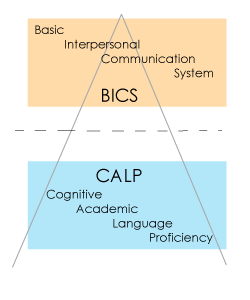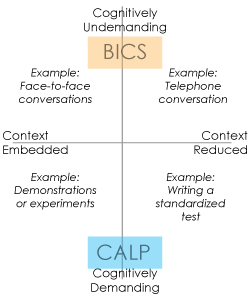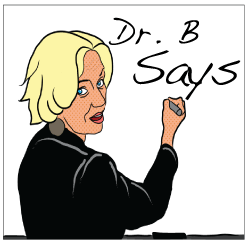 BICS/CALP:
BICS/CALP:
Basic Interpersonal Communicative Skills vs. Cognitive Academic Language
Proficiency
As is the case with Daniel, many mainstream teachers who teach ELL students will find a disparity between the language these students use for conversation and that which is used for more academic purposes. Daniel has heard his student speak with his friends and has judged him to be “fluent”. The danger of this assumption is that teachers can often misjudge the language level of ELL students and therefore when academic work is analyzed, it can appear to the teacher as though the student is not working to their ability. This, in turn, can lead to misconceptions about the intelligence or motivation levels of ELL students. In order to better understand this concept, we can look at the work of Jim Cummins who demonstrates this idea through two language continua called BICS (Basic Interpersonal Communicative Skills) and CALP (Cognitive Academic Language Proficiency). |
back to case study |
What is BICS & CALP?
 These terms are commonly used in discussion of bilingual education and arise from the early work of Cummins (1984) in which he demonstrated his ideas about the two principal continua of second language development in a simple matrix. BICS describes the development of conversational fluency (Basic Interpersonal Communicative Skills) in the second language, whereas CALP describes the use of language in decontextualized academic situations (Cognitive Academic Language Proficiency ).
These terms are commonly used in discussion of bilingual education and arise from the early work of Cummins (1984) in which he demonstrated his ideas about the two principal continua of second language development in a simple matrix. BICS describes the development of conversational fluency (Basic Interpersonal Communicative Skills) in the second language, whereas CALP describes the use of language in decontextualized academic situations (Cognitive Academic Language Proficiency ).
According to Baker (2006) "BICS is said to occur when there are contextual supports and props for language delivery. Face-to-face `context embedded´ [boldface in original] situations provide, for example, non-verbal support to secure understanding. Actions with eyes and hands, instant feedback, cues and clues support verbal language. CALP, on the other hand, is said to occur in 'context reduced' [boldface in original] academic situations. Where higher order thinking skills (e.g. analysis, synthesis, evaluation) are required in the curriculum, language is `disembedded´ [boldface in original] from a meaningful, supportive context. Where language is `disembedded´ the situation is often referred to as `context reduced´ [boldface in original]." (Baker, 2006, p. 174)
The horizontal axis of the BICS/CALP matrix represents a continuum from 'context-embedded' to 'context-reduced', ranging from the situation in which the learner uses external clues and information, such as facial gestures, real objects and pictorial representation to enable understanding, to the other extreme where the learner must rely on linguistic cues, and knowledge about language and text to understand meanings. The vertical axis relates to the degree of active cognitive involvement in a task, moving from tasks that are not very demanding to increasing cognitively challenging activities. So, an activity in the upper left corner (cognitively undemanding and context-embedded) such as face to face conversations might be appropriate for a beginner, but tasks in the lower right corner (more cognitively demanding and context-reduced) such as writing a standardized test, would be a task for advanced learners. Cummins' model has pr oved helpful in identifying and developing appropriate tasks for bilingual pupils. For example, in preparing tasks for a newly arrived second language learner, teachers might start with contextualized tasks and practical activities that are of low cognitive demand, such as naming items or a simple matching exercise. More proficient learners would require contextual support, but would need more cognitively demanding tasks. This approach to planning and assessing ELL learners was developed and reported in Cline and Frederickson (1996).
oved helpful in identifying and developing appropriate tasks for bilingual pupils. For example, in preparing tasks for a newly arrived second language learner, teachers might start with contextualized tasks and practical activities that are of low cognitive demand, such as naming items or a simple matching exercise. More proficient learners would require contextual support, but would need more cognitively demanding tasks. This approach to planning and assessing ELL learners was developed and reported in Cline and Frederickson (1996).
In conceptualizing bilingual proficiency this way, Cummins and other researchers suggest that it takes learners, on average, approximately two years to achieve a functional, social use of a second language but that it may take five to seven years or longer, for some bilingual learners to achieve a level of academic linguistic proficiency comparable to monolingual English speaking peers.
back to top
What are some examples of BICS & CALP?
Basic Interpersonal Communication Skills (BICS) The commonly used acronym BICS describes social, conversational language used for oral communication. Also described as social language, this type of communication offers many cues to the listener and is context-embedded language. Usually it takes about two years for students from different linguistic backgrounds to comprehend context-embedded social language readily. English language learners can comprehend social language by:
|
Cognitive Academic Language Proficiency (CALP) CALP is the context-reduced language of the academic classroom. It takes five to seven years for English language learners to become proficient in the language of the classroom because:
|
Info from: http://www.thecenterlibrary.org/cwis/cwisdocs/intro-ells.pdf
How can we determine if a task or exercise falls within the BICS or CALP continua?
By using a matrix with two axes (Context-Embedded language and Context-reduced language) we can see how certain task may be more or less demanding.
CONTEXT-EMBEDDED LANGUAGE:
 Language that is supported by contextual clues in the environment such as objects, props, manipulatives, pictures, graphs, charts and so forth helps the second language learner make meaning from the spoken or written world. Context-embedded language is also a result of students interacting with each other to get interpersonal clues to further construct meaning. A "here and now" context is a necessary ingredient if the input is going to be comprehensible.
Language that is supported by contextual clues in the environment such as objects, props, manipulatives, pictures, graphs, charts and so forth helps the second language learner make meaning from the spoken or written world. Context-embedded language is also a result of students interacting with each other to get interpersonal clues to further construct meaning. A "here and now" context is a necessary ingredient if the input is going to be comprehensible.
CONTEXT-REDUCED LANGUAGE:
In decontextualized language there are few if any clues present to support the spoken or written words to help make the language comprehensible. Context-reduced language is abstract and the context is usually known only to the author. i.e., textbooks, a novel, a lecture, a CTBS test. Quadrant C and Quadrant D are context-reduced according to Jim Cummin's construct of proficiency.
back to top
 |
Test your knowledge about BICS/CALP with this quiz. |

Baker, C. (2006). Foundations of bilingual education and bilingualism (4th Edition).
Clevedon, England, Buffalo, N.Y.: Multilingual Matters.
BICS & CALP Explained by Jim Cummins
http://www.iteachilearn.com/cummins/bicscalp.html




